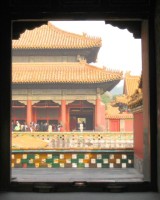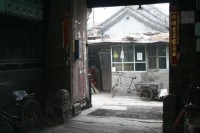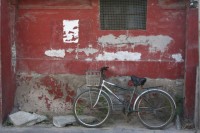Thu 1 Nov 2007

Standing in the middle of Tiananmen Square a few days ago, I looked up at a monstrously huge portrait of Mao and finally began to understand that, although Beijing often feels a lot like New York, China and the US, in some ways, are still a world a part. The sharp elbow to my ribs delivered by the elderly Chinese woman next to me only reinforced this point.  I don’t know if it’s simply tradition or if it’s a custom born of being in a country with so many other people (1.3 billion!), but Chinese people seem to have a very different concept of personal space than what I’m used to…i.e., they don’t seem to really believe in it. My tiny assailant was trying to get by me in order to have a better view of the military guards who were lowering the Chinese flag in the square, as they do at every sundown. I stood my ground, in part because we onlookers were packed so tightly together that I had nowhere to move, and she adapted by reaching around me and snapping few pictures. The ceremony itself was well worth the jostling, if only for the opportunity to photograph the Chinese military in action.

The next day, we walked under Mao’s glaring countenance, through the Gate of Heavenly Peace and into the Forbidden City. Looking around the clusters of ancient buildings, which once housed two dynasties of emperors and was off-limits to the public for some 500 years (hence its name), it all felt a little surreal. Although we soon discovered that the largest and most important structure, the Hall of Supreme Harmony, was completely obscured by a web of scaffolding–sad!–nearly everything else was on full display. Despite the cold (Beijing in late fall feels a lot like Michigan: crisp and chilly), we spent a happy few hours wandering the complex and learning as much as we could from our audio guides. (Hey, no one ever said we were cool…)

Later, after some fierce bargaining over the fare, we boarded a trishaw and journeyed into the narrow alleyways of Beijing’s hutong. Hutong are warren-like clusters of ramshackle, one-storey houses that are scattered throughout the city. Although 1/4 of Beijing’s residents currently live in them, a lot of hutong are facing demolition as part of the city’s pre-Olympic gentrification.  They’re run-down, but full of character; we quickly fell in love with them. (In fact, as I write this, I’m tucked into a corner of a cozy coffee shop in our favorite hutong.) I think pictures probably explain their beauty a lot better than my words can…

A dearth of train tickets means that we’ll be in Beijing for a bit longer than we’d planned. Frankly, I couldn’t be happier. We could be here for months and still not take it all in.
[embedplusvideo height=”350″ width=”450″ editlink=”http://bit.ly/1tauhds” standard=”http://www.youtube.com/v/5IXCO41GpKw?fs=1″ vars=”ytid=5IXCO41GpKw&width=450&height=350&start=&stop=&rs=w&hd=0&autoplay=0&react=1&chapters=¬es=” id=”ep6862″ /]
How’s the internet access there? Do you guys have the sense that the government firewalls would prevent you from uploading posts that veer too close to the politically taboo?
RESPONSE:
The Chinese firewall does block several sites that we use for the website, including youtube, Google video, wikipedia and parts of flickr. We’ve had to make several adjustments to how we administer the site.
We have used some restraint in what we post, since we’re aware that there are thousands of government employees monitoring the web every day. We’d hate to have our site blocked while we’re here.